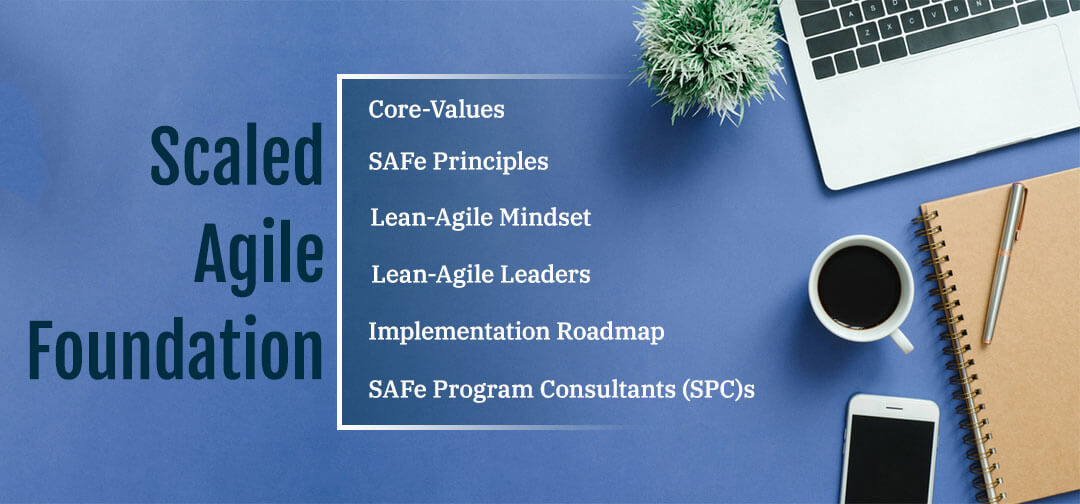
Preeth Pandalay
An executive turned transformation consultant with 25+ years of learning, Preeth trains and coaches... Read more

An executive turned transformation consultant with 25+ years of learning, Preeth trains and coaches... Read more

SAFe 5.0 empowers business agility and enhances business outcomes for organizations of all capacities, worldwide. It has turned out drastic improvements in time-to-market, higher customer satisfaction, employee engagement, improved economic outcomes, and superior quality.
SAFe also helps to create cultures that are rewarding, fun, and productive at the same time. SAFe 5.0 training is expanding its guidance for Lean-Agile adoption in the government. SAFe holds up the complete range of development environments alongside four out-of-the-box configurations.
Unlock agile success with Leading SAFe® training. Comprehensive guide to mastering SAFe® principles & practices for effective organizational transformation.
EXPLORE TODAY
1. Essential SAFe: The Essential SAFe configuration is considered to be the simplest origin for implementation. Also, it is the basic building block for all the SAFe configurations. The Essential SAFe configuration is built on the practices and principles that are present in the Lean-Agile leadership competency, the Agile Product Delivery Competency, and the Team and Technical Agility Competency.
SAFe is held together by an organizational structure known as ‘Agile Release Train’, where the key stakeholders, Agile teams, and other resources are dedicatedly working on a significant ongoing solution mission.
2. Large Solution SAFe: The Large Solution SAFe configuration establishes the Enterprise Delivery competency. This supports those who build the most complex and largest solutions that require multiple suppliers and Agile Release Trains, but not the portfolio level considerations. These kinds of solution development are most commonly used for industries such as automotive, aerospace and defense, and the government. In these cases, the large solution becomes the primary concern instead of portfolio governance.
3. Portfolio SAFe: The Portfolio SAFe configuration is the minimal set of practices and competencies that completely authorize business agility in a Lean enterprise. Portfolio SAFe extends an additional three to the three core competencies of Essential SAFe. Lean portfolio management organises development around the flow of value through one or more value streams. It also aligns portfolio execution to enterprise strategy.
Organisational agility puts forth lean thinking and practices throughout the enterprise meanwhile enabling strategy agility. Continuous learning culture explains how every individual in the organisation learns together, improves together and builds innovation. Along with the competencies, Portfolio SAFe also provides principles and practices for Agile portfolio operations, portfolio strategy & investment funding, Lean governance, etc.
4. Full SAFe: Full SAFe comprises all the seven competencies that are needed for business agility and is also the most comprehensive or detailed configuration. It is used by the largest enterprises worldwide to maintain portfolios of complex and large solutions. Although, in a few scenarios, multiple instances of different SAFe configurations could be required.
5. The Spanning Palette: The Spinning Palette constitutes several roles and artifacts that might be applicable to a particular team, large solution, program, or even portfolio extent. It is also an essential element of the SAFe’s configurability and flexibility. However, it permits the organizations to apply just one of the items needed for the configuration. The two versions of the spanning palette are:


The foundation comprises of values, supporting principles, implementation guidelines, mindset, leadership roles and other factors that are required to deliver value successfully at scale. Take a look at each foundation element described below:
Yes, organizations often use multiple SAFe configurations together, such as Essential SAFe for teams and Portfolio SAFe for governance.
Large Solution SAFe is particularly useful for industries like automotive, aerospace, defense, and government, where complex solutions with multiple suppliers are needed.
SPCs act as change agents, helping organizations implement SAFe, improve processes, and drive Agile transformations successfully.
An executive turned transformation consultant with 25+ years of learning, Preeth trains and coaches organizations to be agile and more importantly to stay agile. Preeth’s pragmatism finds its root in his diverse experience at various leadership positions.
WhatsApp Us
An Excellent PSPO I Training Session by Sumeet. His Examples Were Related Real Live Scenarios Based on Scrum Concepts an...

Thank you Preeth Pandalay for being a great mentor/instructor who has led me to score 100% in PSM2 certification exam in...

I recently attended PSM II training class led by an exceptional Professional Scrum Trainer, Preeth Pandalay. His deep ex...

Excellent instructor, vast knowledge and unique way of explanation

I have completed my training from Preeth Pandalay on 14-15 June. Training was very much to the point . He is a very good...

We will get back to you soon!
For a detailed enquiry, please write to us at connect@agilemania.com
We will get back to you soon!
For a detailed enquiry, please write to us at connect@agilemania.com



